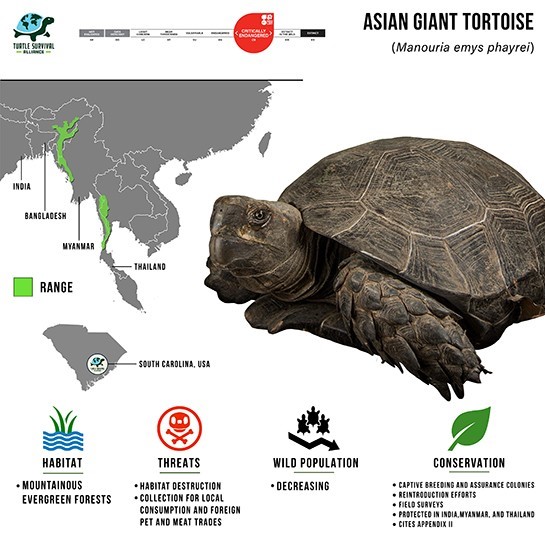Context:
Recently, 10 critically endangered Asian Giant Tortoises (Manouria emys) were reintroduced into the Zeliang Community Reserve in Nagaland’s Peren district. This reintroduction was conducted by the Nagaland Forest Department and the India Turtle Conservation Programme (ITCP).
- A unique aspect of this conservation effort is the engagement of local youths as "Tortoise Guardians." These guardians will ensure the protection of the released tortoises and assist in data collection.
About Asian Giant Tortoise:
The Asian Giant Tortoise (Manouria emys) is the largest land tortoise in mainland Asia and plays a vital ecological role in tropical forest ecosystems. As a slow-moving herbivore, it aids in seed dispersal, soil turnover, and maintaining forest health, earning it the nickname “small elephant of the forest.”
Habitat & Distribution
It inhabits moist tropical and subtropical forests across India, Bangladesh, Myanmar, Thailand, Malaysia, and Indonesia. In India, it was once widely found in Northeast India, especially Nagaland and Arunachal Pradesh.
Conservation Status
· IUCN Red List: Critically Endangered
· Wildlife (Protection) Act, 1972: Schedule IV species
Key Characteristics
· Size: Up to 60 cm long, weighs over 35 kg
· Shell: Dark, heavily domed with visible growth rings
· Limbs: Thick, scaly legs with elephant-like feet
· Lifespan: 80–100 years
· Diet: Leaves, fruits, mushrooms, and decaying plant matter
· Activity: Diurnal and solitary, thrives in humid forests
Unique Traits
About India Turtle Conservation Programme (ITCP):
The program focuses on breeding threatened turtle species in captivity and reintroducing them into the wild.
· For example, the Asian Giant Tortoise, a critically endangered species, is being reintroduced with the help of local youth trained as "parabiologists".
· ITCP emphasizes community involvement and awareness. Local communities are engaged in patrolling, data collection, monitoring, and raising awareness about turtle conservation.
About Community reserves:
Community reserves are areas established on private or community land, designated by the State Government to conserve flora and fauna with the consent of local communities.
· These reserves aim to improve socioeconomic conditions and protect local customs, cultures, and practices alongside wildlife conservation.
· They are managed by a Community Reserve Management Committee and fall under the purview of the Wildlife Protection Act (WLPA), 1972.
Conclusion:
This conservation initiative highlights the effectiveness of community-led conservation models. The Zeliang Community Reserve, where the tortoises were released, is one of the many community and conservation reserves in Nagaland that have proven to be successful in preserving forests and wildlife under joint leadership of communities and the Forest Department.







